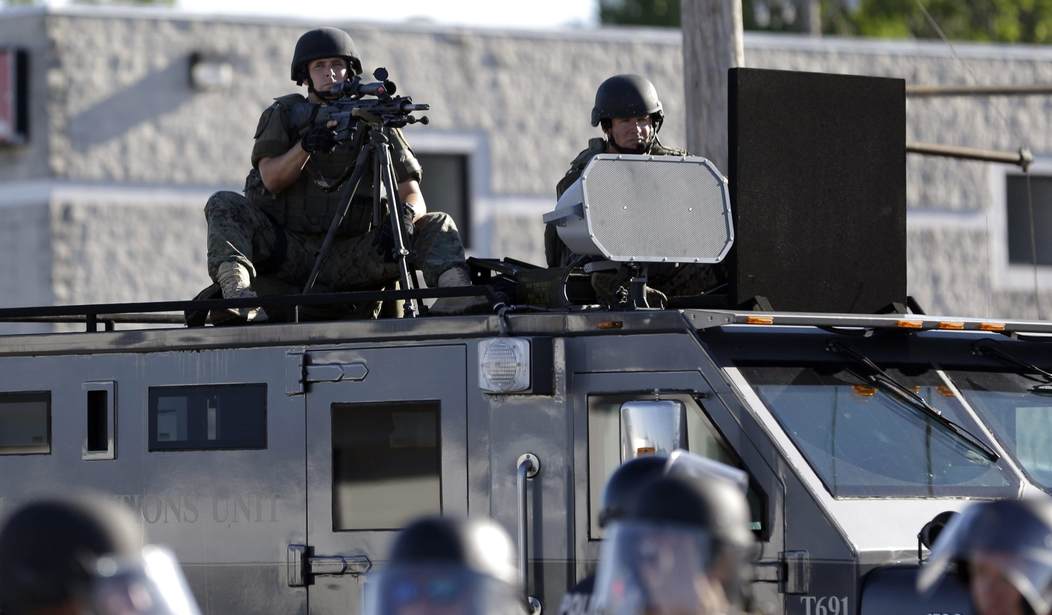WASHINGTON – Sen. Pat Toomey (R-Pa.) on Wednesday re-introduced legislation that would reverse an Obama-era directive restricting police department access to surplus military equipment and weapons.
Obama issued the directive in May 2015 following public backlash over military equipment that police used during protests that erupted after Michael Brown’s controversial death in Ferguson, Mo. The surplus items issued by the Department of Defense through the so-called 1033 program have included riot helmets, riot shields and armored vehicles. The list of restricted items includes grenade launchers, tanks and .50 caliber weapons. Obama said at the time that the militarized gear can “alienate and intimidate local residents and send the wrong message,” and the administration began confiscating certain gear from local police in 2016.
Toomey described many of the confiscated items as “purely defensive” and necessary, especially in circumstances where rioters are setting vehicles on fire and tossing bricks, cement blocks and glass bottles at police. Toomey also noted that armored vehicles were critical in recovering hostages during the 2016 Orlando nightclub terrorist attack.
“Every day, America’s public safety officers place themselves in harm’s way to protect the rest of us. For this, they deserve our gratitude,” Toomey said in a statement Thursday, a day after re-introducing the Lifesaving Gear for Police Act. “Instead, our law enforcement officers have been unfairly maligned and, too often, attacked simply for the uniform they wear – for their decision to protect and serve.”
The legislation received support from a handful of law enforcement groups, including the Federal Law Enforcement Officers Association (FLEOA), the Fraternal Order of Police and the International Union of Police Associations.
In an interview with PJ Media on Thursday, FLEOA’s executive vice president, Donald J. Mihalek, said the Obama administration’s decision was made to appease a vocal group of constituents.
“The Obama administration was reacting to a set of circumstances, and probably overreacting, to a dialogue from the public that took all the gear that was part of this program and labeled it as an over-militarization of police departments,” Mihalek said.
Like Toomey, he described most of the equipment offered through the 1033 program as defensive, and argued that it’s critical to small, local police departments that are under-funded and under-staffed. Mihalek pointed to the Pulse nightclub shooting, as well as the July 2016 ambush of Dallas police officers in which five were killed and nine injured by Afghan War veteran Micah Johnson.
“The only way that Dallas police officers could address that threat was through some of the material that they could potentially access through the 1033 program, whether it was the body armor or armored vehicles,” he said.
Discussing the Orlando attack, Mihalek said that in any hostile situation involving a bunkered assailant most departments use armored vehicles.
Kanya Bennett, legislative council with the ACLU, in an interview Friday disputed the characterization that Obama’s directive was a prohibition on all items offered through the 1033 program. She described it as a series of parameters and policies for doling out military-style equipment.
“The frame for this bill that suggests that the Obama administration took all of this lifesaving gear away from police is not accurate,” Bennett said. “There were very few items that were prohibited.”
ACLU’s stance, she said, is that there is utility for some of the 1033 equipment, in high-stakes scenarios like Orlando and Dallas, but the concern has always been that the equipment is being used in low-level activities.
“That has always been our concern – that you’re using grenades, using armored vehicles in the middle of the night to do a drug bust for $50 worth of drugs,” Bennett said. “When the federal government intervened, it was not an attempt to take away these things so that they could never be used. It was, again, to try to encourage law enforcement to use them when and where appropriate.”
Along with the Lifesaving Gear for Police Act, Toomey also reintroduced two separate law-enforcement-related bills this past week: the Lieutenant Osvaldo Albarati Correctional Officer Self-Protection Act and the Thin Blue Line Act. The first would allow correctional officers to carry personal firearms while traveling to and from work. The legislation was drawn up in response to the death of Lt. Osvaldo Albarati, a federal correctional officer in Puerto Rico who was gunned down in 2013 by an inmate-hired shooter. The second piece of legislation would strengthen penalties for criminals who murder or target local law enforcement officers, prosecutors and first responders. The bill would extend penalties that are currently levied for crimes against federal officers and prosecutors.








Join the conversation as a VIP Member